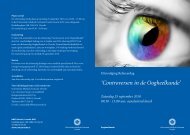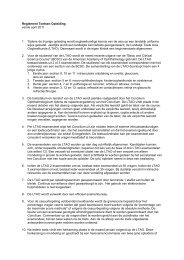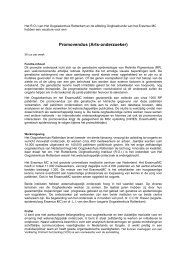terminology and guidelines for glaucoma ii - Kwaliteitskoepel
terminology and guidelines for glaucoma ii - Kwaliteitskoepel
terminology and guidelines for glaucoma ii - Kwaliteitskoepel
You also want an ePaper? Increase the reach of your titles
YUMPU automatically turns print PDFs into web optimized ePapers that Google loves.
Inclusion of all commercially available drugs<br />
Careful quality control <strong>and</strong> feedback to technicians <strong>and</strong> photographers<br />
True-incidence cases<br />
-Weaknesses<br />
Limited IOP range, i.e. no in<strong>for</strong>mation on higher or lower IOPs than the selection criteria<br />
Sample is from healthy volunteers <strong>and</strong> not population based<br />
Relatively small number of POAG endpoints<br />
Limited to patients with reliable visual fields<br />
High thresholds <strong>for</strong> endpoints<br />
Some risk factors under-represented<br />
Criteria <strong>for</strong> conversion to POAG adjusted during study<br />
If a correction factor was applied at baseline <strong>for</strong> CCT, up to 57% of white subjects <strong>and</strong> up to 37 % of black subjects<br />
would have corrected IOPs. If such an adjustment had been made at baseline some would not have had OH.<br />
Some of the patients with normal white-on-white perimetry were later reported (ARVO 2002) to have had SWAP<br />
defects at baseline, thereby casting doubt on the “normal” state of some of the participants.<br />
II.2 - COLLABORATIVE INITIAL GLAUCOMA TREATMENT STUDY (CIGTS)<br />
R<strong>and</strong>omized clinical trial on 607 patients with newly diagnosed open-angle <strong>glaucoma</strong><br />
Initial treatment was either medication or trabeculectomy (with or without 5-fluorouracil)<br />
A target IOP algorithm was used to guide the IOP lowering treatment.<br />
Patients were treated as aggressively as needed in an ef<strong>for</strong>t to reduce IOP to a level at or below a predetermined target<br />
pressure specific <strong>for</strong> each individual eye<br />
Primary outcome variables were VF loss <strong>and</strong> Quality of Life (QoL).<br />
Secondary outcome variables were Visual Acuity (VA) IOP, Cataract <strong>for</strong>mation.<br />
Inclusion criteria were: (a) IOP 20 mmHg or higher with Humphrey visual field defect of at least three contiguous<br />
points <strong>and</strong> an optic disc which was considered compatible with <strong>glaucoma</strong>, or (b) IOP of 20 - 26 mmHg with two contiguous<br />
defect points in the visual field, or (c) an IOP of 27 mmHg <strong>and</strong> higher without visual field damage <strong>and</strong> suspected<br />
<strong>glaucoma</strong>tous disc.<br />
Summary of results 5<br />
On the basis of completed follow-up through 4 years <strong>and</strong> partially completed through 5 years, VF progression did<br />
not differ significantly by initial treatments.<br />
IOP was lower with surgery (average 14-15 mmHg) than with medications (average 17-18 mmHg), decreasing 35%<br />
with medications <strong>and</strong> 48% with surgery. Perimetry results were equal <strong>and</strong> MD remained stabile in both groups. QoL<br />
was initailly better with drugs (mostly betablockers)<br />
Both medications <strong>and</strong> surgery increased the incidence of cataract extraction (6% vs 17%).<br />
Medical treatment (including cross-over) reduced IOP from 27 to 17 mmHg i.e. 10 mmHg or 37%. VA decreased initially<br />
more in the surgical group: it was equal at the end of follow-up.<br />
ALT lowered the IOP after both medications <strong>and</strong> surgery.<br />
- Strengths<br />
Individualized target IOP approach<br />
Newly diagnosed patients<br />
QoL prospectively addressed<br />
- Weaknesses<br />
Inclusion criteria may have allowed recruitment of OH resulting in a case mix with little risk of showing progression<br />
Sequence of treatment steps <strong>and</strong> cross over not clearly underst<strong>and</strong>able<br />
Initial trabeculectomy was sometimes supplemented with 5-FU<br />
Follow up might not be long enough to show differences<br />
Ch. Intro 6 EGS
















